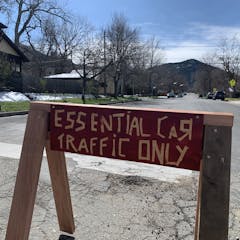
Articles on Bicycling
Displaying 1 - 20 of 87 articles

Early in the pandemic, when there was much less traffic on the roads, people took to their bikes. But since then, fewer people are cycling, with rates now lower than in 2011.

Urban development and social norms concerning childhood have led European cities to a situation where public spaces are no more spaces for children and young people.

The bicycle’s capacity to respond to pressing social issues has inspired both intrigue and optimism, especially in the context of COVID-19.

Traffic crashes kill and injure millions worldwide every year and are a major drain on economic development. Improving road safety would produce huge payoffs, especially in lower-income countries.

A new study finds congestion charging and creating car-free streets and separated bike lanes have been most effective at reducing car use in European cities.

We surveyed over 4,000 Victorians and found more than three-quarters are interested in riding a bike, but only in infrastructure that separates people from cars – such as protected bike lanes.

It’s time to stop demonising cyclists and cycling activists as elitists — the accusation fails at the first test.

Riders in the 2021 Tour de France will ride more than 2,100 miles (3,400 km) over the 21 flat and mountainous stages of the race. And they will burn an incredible amount of energy while doing so.

A global study of 117 cities finds Australian capitals have fairly poor access by car. Public transport, cycling and walking access is better than in the US, but not as good as in Europe and China.

Passing distance laws do change driver behaviour. But new research suggests not all the changes are positive.

The pandemic could be a boon to car use, but it would be a mistake for governments to let that happen. There’s a golden opportunity to push towards a zero-carbon transportation system.

The need for social distancing sparked a cycling boom, cutting air pollution and boosting city dwellers’ mental and physical health. But when the pandemic ends, will it be back to life as usual?

And the winner is … e-bikes? A new entrant is set to overtake Brisbane’s CityCycle scheme in the race for the shared mobility market.

Delivery riders are paying the ultimate price for the fact that our cities, their infrastructure and the rules governing them make cycling much more dangerous than it should be.

An increase in cyclists due to the COVID-19 pandemic means that cities need to look at what it means to develop and maintain inclusive bicycle infrastructure.

Australian bicycles are largely influenced by sport, not utility. We should embrace cargo bikes for their usefulness, over speed.

If we’re to get more people walking and cycling in our cities, then we need to make it easier for people, and we can learn from others overseas.

Investing more in cycling and walking would boost both physical and economic health, with a typical return of $5 for every $1 spent on cycling infrastructure.

City streets were built to accommodate cars, but the COVID-19 pandemic has scrambled our transport needs. Many cities are moving to make streets more people-friendly and less car-centric.

Drivers and cyclists develop distinct identities of themselves and others in ways that mirror the formation of ethnic identities. And on-road segregation runs the risk of reinforcing this process.
